TikTok has established itself as one of many high on-line platforms for U.S. teenagers, whereas the share of teenagers who use Fb has fallen sharply
Pew Analysis Middle carried out this examine to raised perceive teenagers’ use of digital units, social media and different on-line platforms. For this evaluation, we surveyed 1,316 U.S. teenagers. The survey was carried out on-line by Ipsos from April 14 to Could 4, 2022.
This analysis was reviewed and permitted by an exterior institutional evaluate board (IRB), Advarra, which is an impartial committee of consultants that makes a speciality of serving to to guard the rights of analysis contributors.
Ipsos recruited the teenagers through their mother and father who have been part of its KnowledgePanel, a probability-based net panel recruited primarily by nationwide, random sampling of residential addresses. The survey is weighted to be consultant of U.S. teenagers ages 13 to 17 who reside with mother and father by age, gender, race, ethnicity, family earnings and different classes.
The development knowledge on this report comes from a Middle survey on the identical matter carried out from Sept. 25, 2014, to Oct. 9, 2014, and from Feb. 10, 2015, to March 16, 2015. The survey was fielded by the GfK Group on its KnowledgePanel, which was later acquired by Ipsos.
Listed below are the questions used for this report, together with responses, and its methodology.
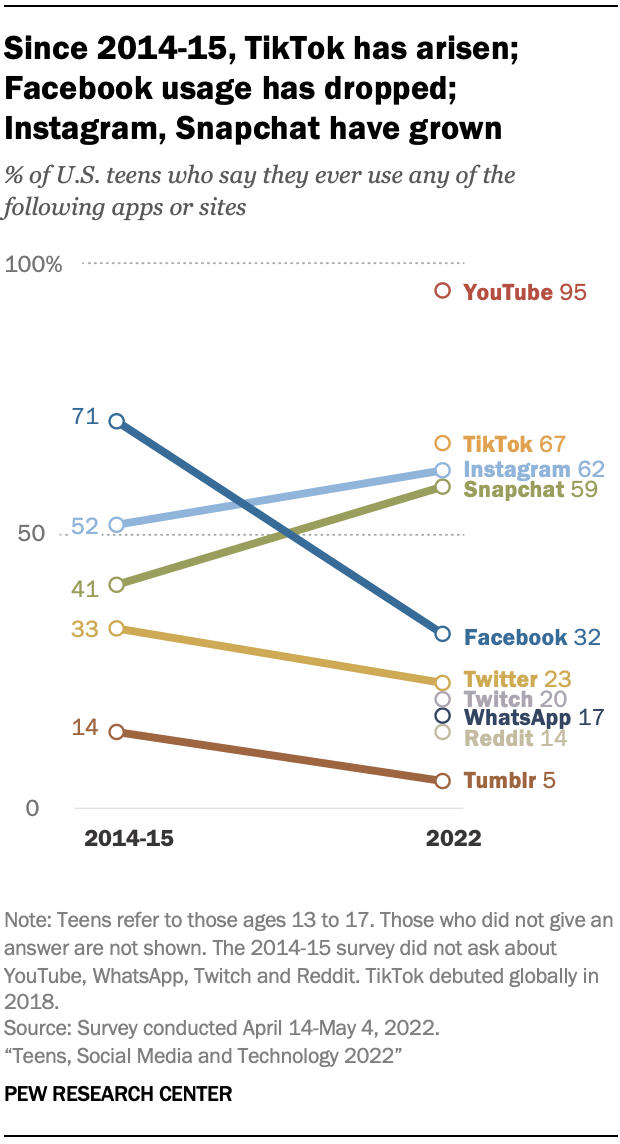
For the most recent survey knowledge on social media and tech use amongst teenagers, see “Teenagers, Social Media, and Expertise 2023.”
The panorama of social media is ever-changing, particularly amongst teenagers who usually are on the vanguard of this area. A brand new Pew Analysis Middle survey of American youngsters ages 13 to 17 finds TikTok has rocketed in reputation since its North American debut a number of years in the past and now’s a high social media platform for teenagers among the many platforms lined on this survey. Some 67% of teenagers say they ever use TikTok, with 16% of all teenagers saying they use it virtually always. In the meantime, the share of teenagers who say they use Fb, a dominant social media platform amongst teenagers within the Middle’s 2014-15 survey, has plummeted from 71% then to 32% right this moment.
YouTube tops the 2022 teen on-line panorama among the many platforms lined within the Middle’s new survey, as it’s utilized by 95% of teenagers. TikTok is subsequent on the listing of platforms that have been requested about on this survey (67%), adopted by Instagram and Snapchat, that are each utilized by about six-in-ten teenagers. After these platforms come Fb with 32% and smaller shares who use Twitter, Twitch, WhatsApp, Reddit and Tumblr.
Modifications within the social media panorama since 2014-15 prolong past TikTok’s rise and Fb’s fall. Rising shares of teenagers say they’re utilizing Instagram and Snapchat since then. Conversely, Twitter and Tumblr noticed declining shares of teenagers who report utilizing their platforms. And two of the platforms the Middle tracked within the earlier survey – Vine and Google+ – now not exist.
There are some notable demographic variations in teenagers’ social media decisions. For instance, teen boys are extra seemingly than teen women to say they use YouTube, Twitch and Reddit, whereas teen women are extra seemingly than teen boys to make use of TikTok, Instagram and Snapchat. As well as, larger shares of Black and Hispanic teenagers report utilizing TikTok, Instagram, Twitter and WhatsApp in contrast with White teenagers.
This examine additionally explores the frequency with which teenagers are on every of the highest 5 on-line platforms: YouTube, TikTok, Instagram, Snapchat and Fb. Absolutely 35% of teenagers say they’re utilizing not less than one among them “virtually always.” Teen TikTok and Snapchat customers are significantly engaged with these platforms, adopted by teen YouTube customers in shut pursuit. 1 / 4 of teenagers who use Snapchat or TikTok say they use these apps virtually always, and a fifth of sweet sixteen YouTube customers say the identical. When teenagers general, 19% say they use YouTube virtually always, 16% say this about TikTok, and 15% about Snapchat.
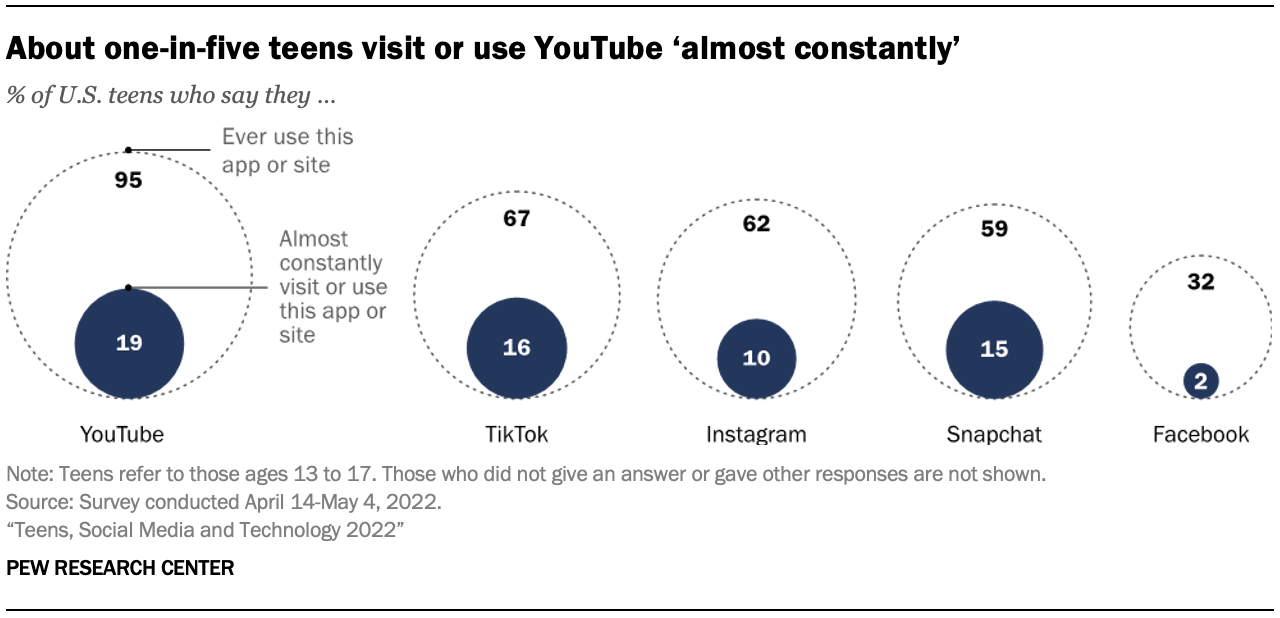
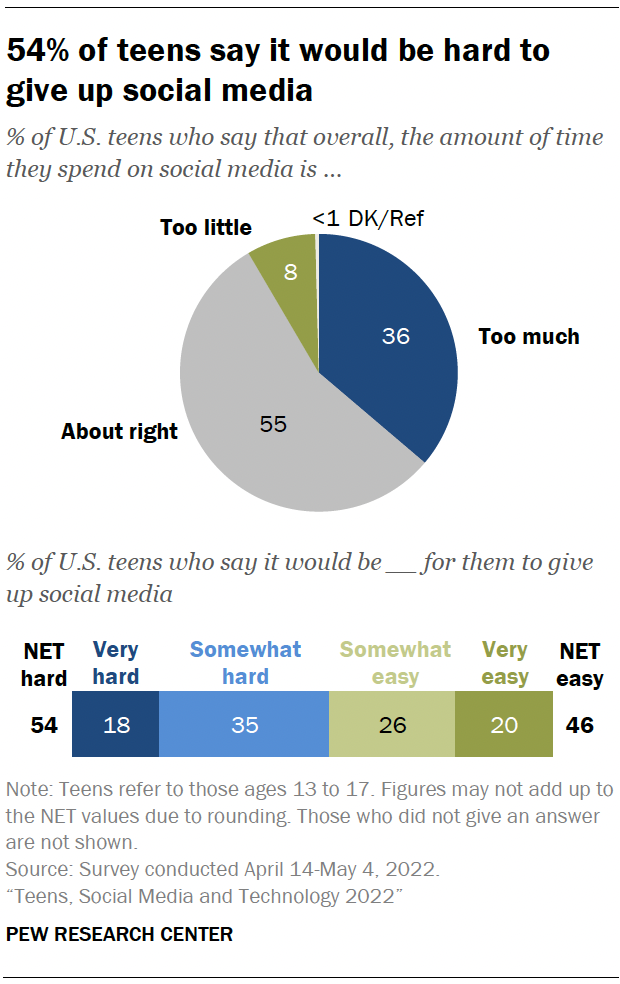
When reflecting on the period of time they spend on social media typically, a majority of U.S. teenagers (55%) say they spend about the correct quantity of time on these apps and websites, whereas a couple of third of teenagers (36%) say they spend an excessive amount of time on social media. Simply 8% of teenagers suppose they spend too little time on these platforms.
Requested in regards to the concept of giving up social media, 54% of teenagers say it could be not less than considerably laborious to present it up, whereas 46% say it could be not less than considerably straightforward. Teen women are extra seemingly than teen boys to specific it could be tough to surrender social media (58% vs. 49%). Conversely, 1 / 4 of sweet sixteen boys say giving up social media can be very straightforward, whereas 15% of sweet sixteen women say the identical. Older teenagers additionally say they’d have problem giving up social media. About six-in-ten teenagers ages 15 to 17 (58%) say giving up social media can be not less than considerably tough to do. A smaller share of 13- to 14-year-olds (48%) suppose this is able to be tough.
Past simply on-line platforms, the brand new survey finds that the overwhelming majority of teenagers have entry to digital units, comparable to smartphones (95%), desktop or laptop computer computer systems (90%) and gaming consoles (80%). And the examine reveals there was an uptick in each day teen web customers, from 92% in 2014-15 to 97% right this moment. As well as, the share of teenagers who say they’re on-line virtually always has roughly doubled since 2014-15 (46% now and 24% then).
These are among the findings from an internet survey of 1,316 teenagers carried out by the Pew Analysis Middle from April 14 to Could 4, 2022. Extra particulars in regards to the findings on adoption and use of digital applied sciences by teenagers are lined beneath.
Smartphones, desktop and laptop computer computer systems, and gaming consoles stay broadly accessible to teenagers
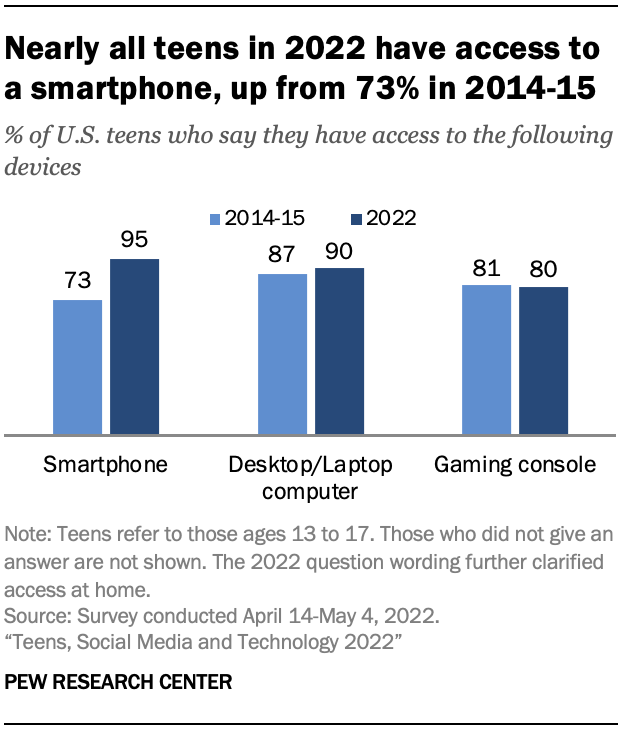
Since 2014-15, there was a 22 proportion level rise within the share of teenagers who report accessing a smartphone (95% now and 73% then). Whereas teenagers’ entry to smartphones has elevated over roughly the previous eight years, their entry to different digital applied sciences, comparable to desktop or laptop computer computer systems or gaming consoles, has remained statistically unchanged.
The survey reveals there are variations in entry to those digital units for sure teams. As an illustration, teenagers ages 15 to 17 (98%) usually tend to have entry to a smartphone than their 13- to 14-year-old counterparts (91%). As well as, teen boys are 21 factors extra prone to say they’ve entry to gaming consoles than teen women – a sample that has been reported in prior Middle analysis.
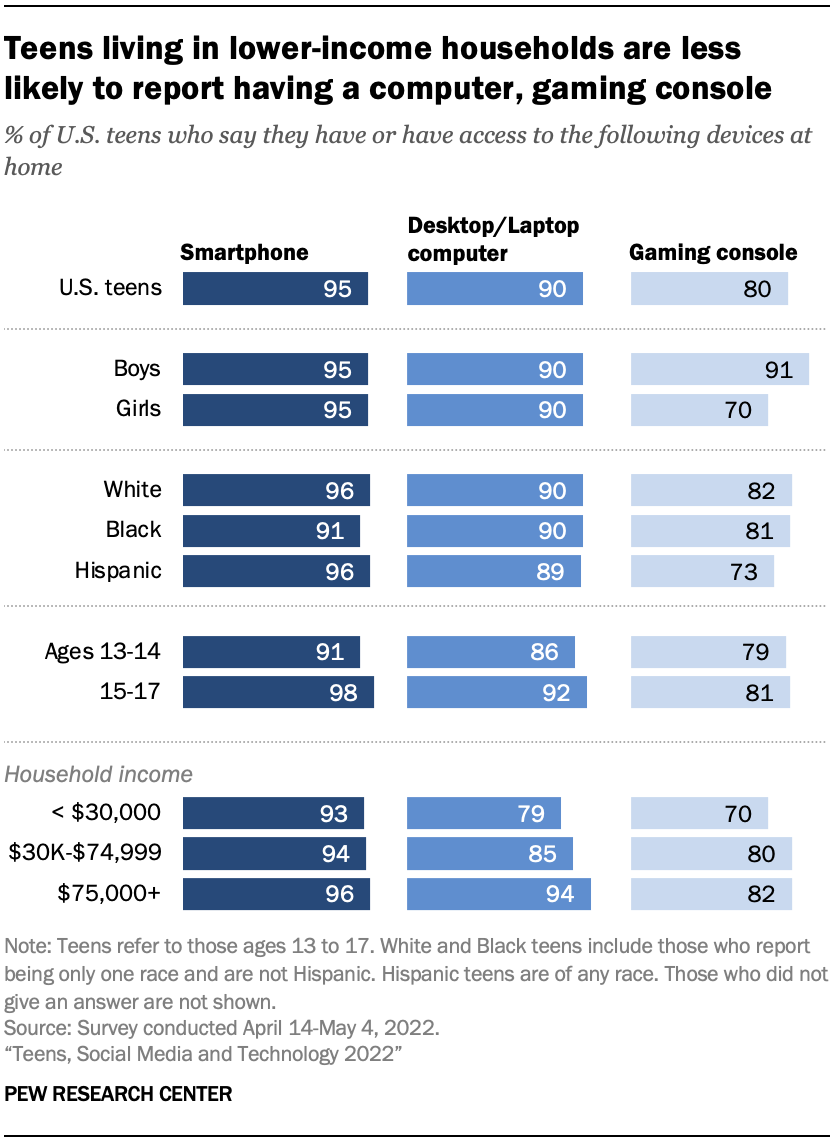
Entry to computer systems and gaming consoles additionally differs by teenagers’ family earnings. U.S. teenagers dwelling in households that make $75,000 or extra yearly are 12 factors extra prone to have entry to gaming consoles and 15 factors extra prone to have entry to a desktop or laptop computer laptop than teenagers from households with incomes beneath $30,000. These gaps in teen laptop and gaming console entry are in step with digital divides by family earnings the Middle has noticed in earlier teen surveys.
Whereas 72% of U.S. teenagers say they’ve entry to a smartphone, a pc and a gaming console at house, extra prosperous teenagers are significantly prone to have entry to all three units. Absolutely 76% of teenagers that reside in households that make not less than $75,000 a yr say they’ve or have entry to a smartphone, a gaming console and a desktop or laptop computer laptop, in contrast with smaller shares of teenagers from households that make lower than $30,000 or teenagers from households making $30,000 to $74,999 a yr who say they’ve entry to all three (60% and 69% of teenagers, respectively).
Nearly all U.S. teenagers report utilizing the web each day
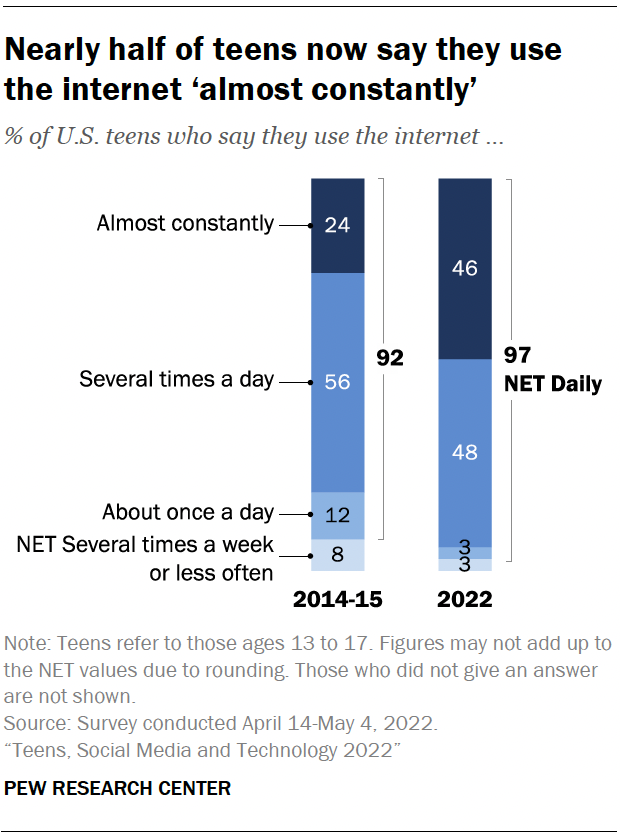
The share of teenagers who say they use the web about as soon as a day or extra has grown barely since 2014-15. As we speak, 97% of teenagers say they use the web each day, in contrast with 92% of teenagers in 2014-15 who mentioned the identical.
As well as, the share of teenagers who say they use the web virtually always has gone up: 46% of teenagers say they use the web virtually always, up from solely a couple of quarter (24%) of youngsters who mentioned the identical in 2014-15.
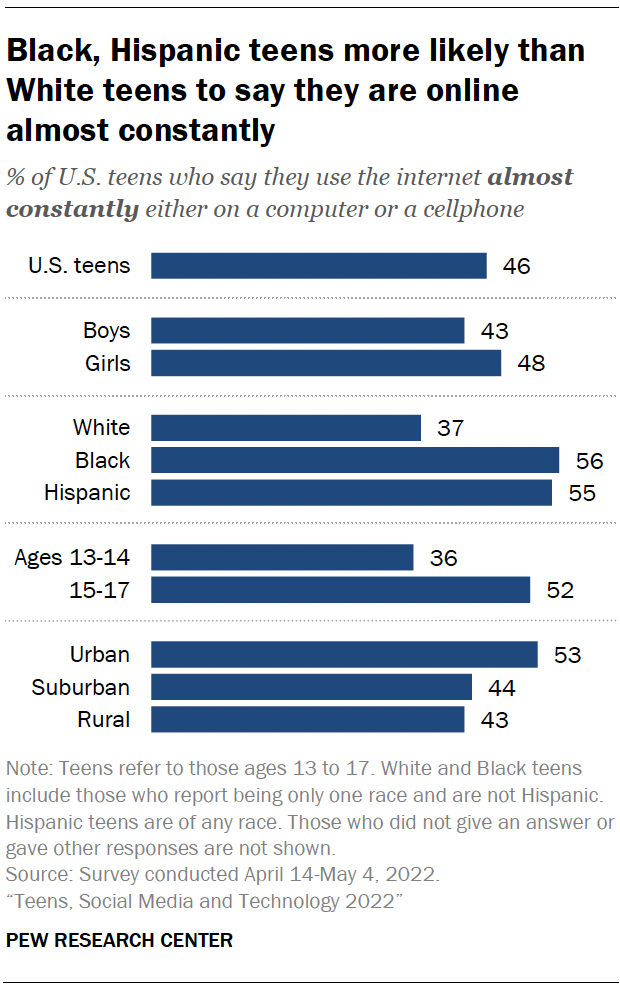
Black and Hispanic teenagers stand out for being on the web extra regularly than White teenagers. Some 56% of Black teenagers and 55% of Hispanic teenagers say they’re on-line virtually always, in contrast with 37% of White teenagers. The distinction between Hispanic and White teenagers on this measure is in step with earlier findings in terms of frequent web use.
As well as, older teenagers usually tend to be on-line virtually always. Some 52% of 15- to 17-year-olds say they use the web virtually always, whereas 36% of 13- to 14-year-olds say the identical. One other demographic sample in “virtually fixed” web use: 53% of city teenagers report being on-line virtually always, whereas considerably smaller shares of suburban and rural teenagers say the identical (44% and 43%, respectively).
Slight variations are seen amongst those that say they interact in “virtually fixed” web use based mostly on family earnings. A barely bigger share of teenagers from households making $30,000 to $74,999 yearly report utilizing the web virtually always, in contrast with teenagers from houses making not less than $75,000 (51% and 43%, respectively). Teenagers who reside in households making beneath $30,000 don’t considerably differ from both group.
The social media panorama has shifted
This survey requested whether or not U.S. teenagers use 10 particular on-line platforms: YouTube, TikTok, Instagram, Snapchat, Fb, Twitter, Twitch, WhatsApp, Reddit and Tumblr.
YouTube stands out as the commonest on-line platform teenagers use out of the platforms measured, with 95% saying they ever use this website or app. Majorities additionally say they use TikTok (67%), Instagram (62%) and Snapchat (59%). Instagram and Snapchat use has grown since requested about in 2014-15, when roughly half of teenagers mentioned they used Instagram (52%) and about four-in-ten mentioned they used Snapchat (41%).
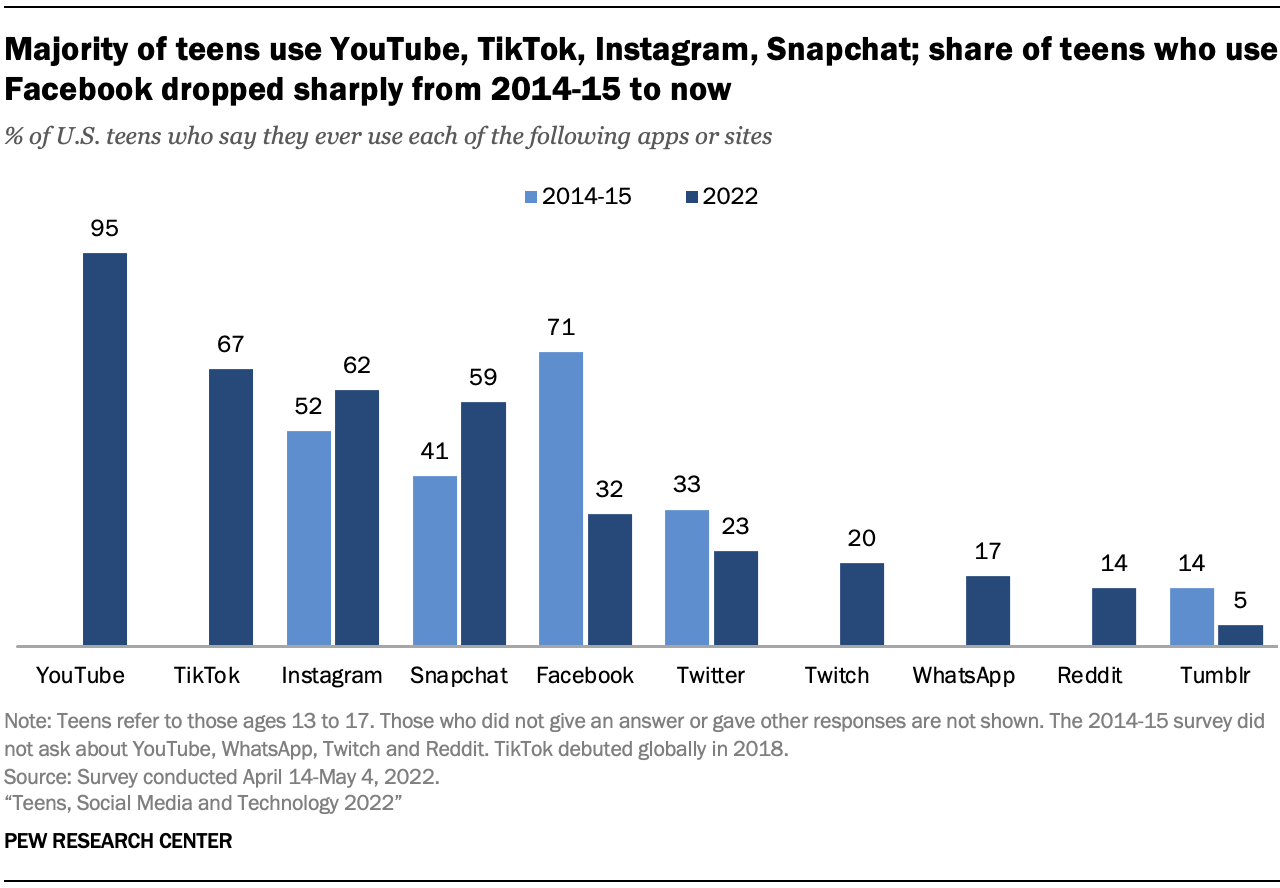
The share of teenagers utilizing Fb has declined sharply prior to now decade. As we speak, 32% of teenagers report ever utilizing Fb, down 39 factors since 2014-15, when 71% mentioned they ever used the platform. Though right this moment’s teenagers don’t use Fb as extensively as teenagers in earlier years, the platform nonetheless enjoys widespread utilization amongst adults, as seen in different current Middle research.
Different social media platforms have additionally seen decreases in utilization amongst teenagers since 2014-15. Some 23% of teenagers now say they ever use Twitter, in contrast with 33% in 2014-15. Tumblr has seen the same decline. Whereas 14% of teenagers in 2014-15 reported utilizing Tumblr, simply 5% of teenagers right this moment say they use this platform.
The net platforms teenagers flock to vary barely based mostly on gender. Teen women are extra seemingly than teen boys to say they ever use TikTok, Instagram and Snapchat, whereas boys are extra seemingly to make use of Twitch and Reddit. Boys additionally report utilizing YouTube at larger charges than women, though the overwhelming majority of teenagers use this platform no matter gender.
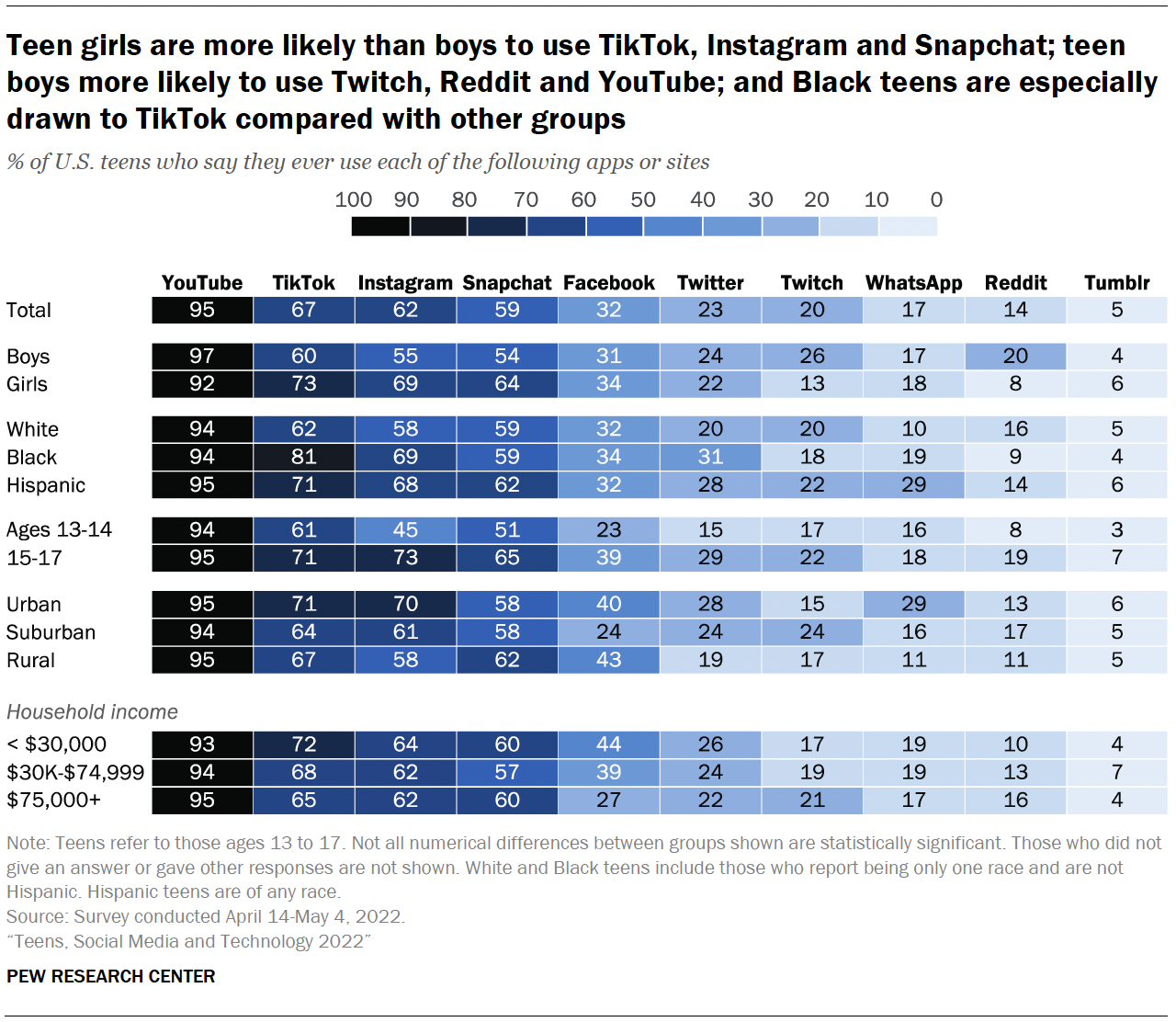
Teenagers’ use of sure on-line platforms additionally differs by race and ethnicity. Black and Hispanic teenagers are extra seemingly than White teenagers to say they ever use TikTok, Instagram, Twitter or WhatsApp. Black teenagers additionally stand out for being extra seemingly to make use of TikTok in contrast with Hispanic teenagers, whereas Hispanic teenagers are extra seemingly than their friends to make use of WhatsApp.
Older teenagers are extra seemingly than youthful teenagers to say they use every of the web platforms requested about apart from YouTube and WhatsApp. Instagram is an particularly notable instance, with a majority of teenagers ages 15 to 17 (73%) saying they ever use Instagram, in contrast with 45% of teenagers ages 13 to 14 who say the identical (a 28-point hole).
Regardless of Fb dropping its dominance within the social media world with this new cohort of teenagers, larger shares of these dwelling in lower- and middle-income households gravitate towards Fb than their friends who reside in additional prosperous households: 44% of teenagers dwelling in households incomes lower than $30,000 a yr and 39% of teenagers from households incomes $30,000 to lower than $75,000 a yr say they ever use Fb, whereas 27% of these from households incomes $75,000 or extra a yr say the identical. Variations in Fb use by family earnings have been present in earlier Middle surveys as effectively (nevertheless the variations by family earnings have been extra pronounced prior to now).
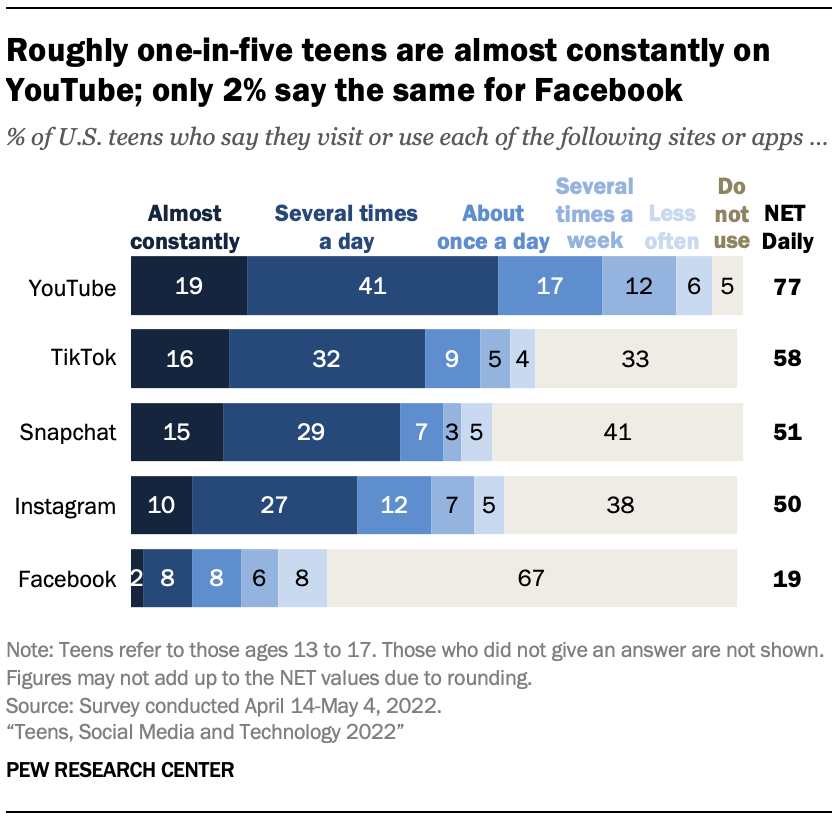
In the case of the frequency that teenagers use the highest 5 platforms the survey checked out, YouTube and TikTok stand out because the platforms teenagers use most regularly. About three-quarters of teenagers go to YouTube not less than each day, together with 19% who report utilizing the location or app virtually always. A majority of teenagers (58%) go to TikTok each day, whereas about half say the identical for Snapchat (51%) and Instagram (50%).
Trying inside teenagers who use a given platform, TikTok and Snapchat stand out for having bigger shares of teenage customers who go to these platforms usually. Absolutely 86% of sweet sixteen TikTok or Snapchat customers say they’re on that platform each day and 1 / 4 of sweet sixteen customers for each of those platforms say they’re on the location or app virtually always. Considerably smaller shares of sweet sixteen YouTube customers (20%) and teenage Instagram customers (16%) say they’re on these respective platforms virtually always (about eight-in-ten teen customers are on these platforms each day).
Not solely is there a smaller share of teenage Fb customers than there was in 2014-15, teenagers who do use Fb are additionally comparatively much less frequent customers of the platform in contrast with the opposite platforms lined on this survey. Simply 7% of sweet sixteen Fb customers say they’re on the location or app virtually always (representing 2% of all teenagers). Nonetheless, about six-in-ten teen Fb customers (57%) go to the platform each day.
Throughout these 5 platforms, 35% of all U.S. teenagers say they’re on not less than one among them virtually always. Whereas this isn’t a complete rundown of all teenagers who use any sort of on-line platform virtually always, this 35% of teenagers symbolize a bunch of comparatively heavy platform customers and so they clearly have completely different views about their use of social media in contrast with those that say they use not less than one among these platforms, although much less usually than “virtually always.” These findings are lined in a later part.
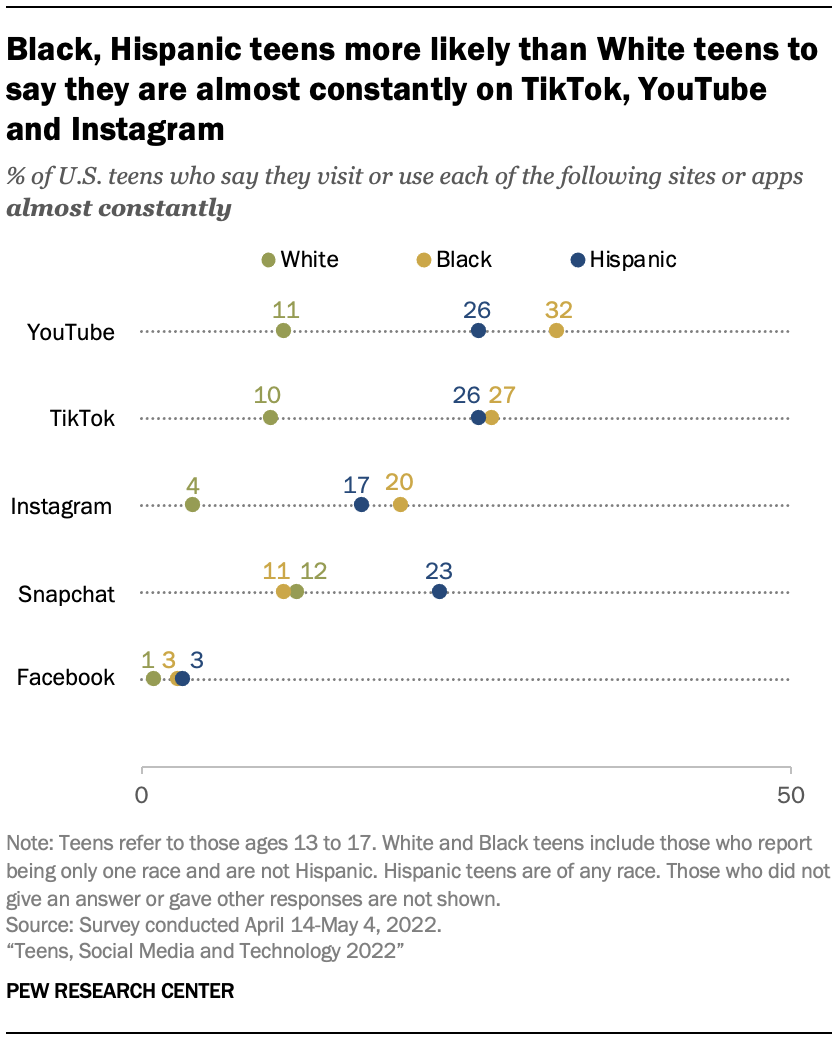
Bigger shares of Black and Hispanic teenagers say they’re on TikTok, YouTube and Instagram virtually always than White teenagers. For instance, Black and Hispanic teenagers are roughly 5 occasions extra seemingly than White teenagers to say they’re on Instagram virtually always.
Hispanic teenagers usually tend to be frequent customers of Snapchat than White or Black teenagers: 23% of Hispanic teenagers say they use this social media platform virtually always, whereas 12% of White teenagers and 11% of Black teenagers say the identical. There are not any racial and ethnic variations in teenagers’ frequency of Fb utilization.
Total, Hispanic (47%) and Black teenagers (45%) are extra seemingly than White teenagers (26%) to say they use not less than one among these 5 on-line platforms virtually always.
Slight majorities of teenagers see the period of time they spend on social media as about proper and say it could be laborious to surrender
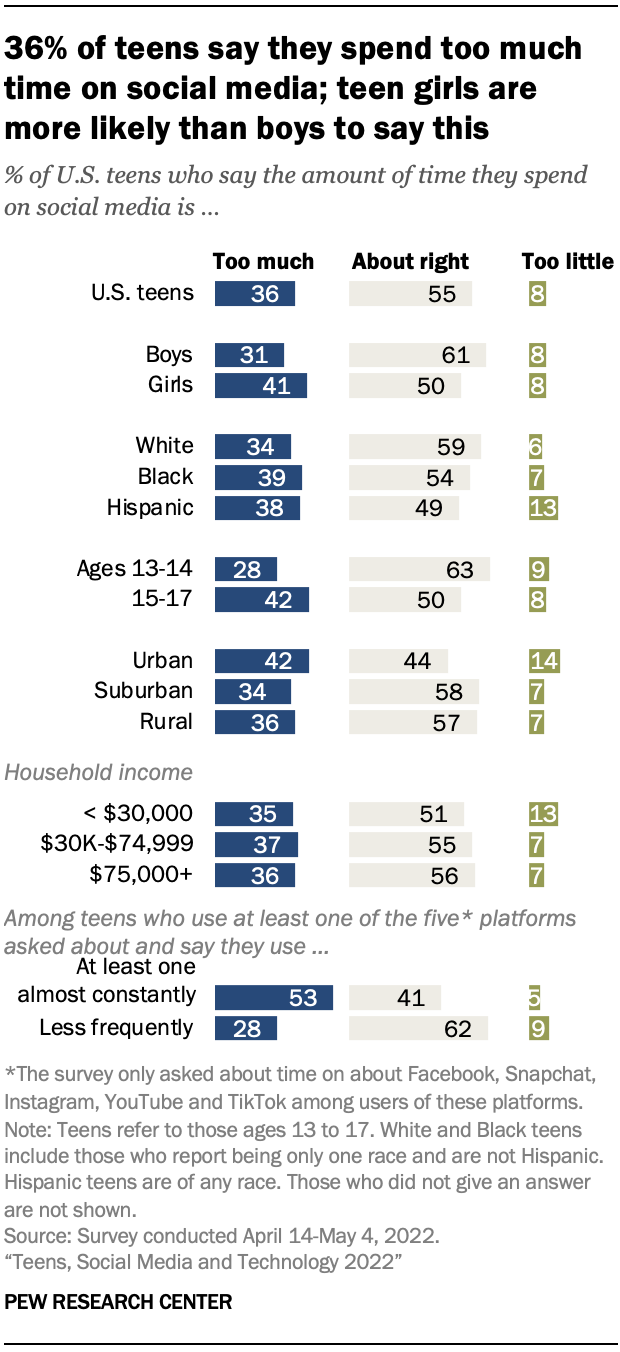
As social media use has turn into a typical a part of many teenagers’ each day routine, the Middle requested U.S. teenagers how they really feel in regards to the period of time they’re spending on social media. A slight majority (55%) say the period of time they spend of social media is about proper, and smaller shares say they spend an excessive amount of time or too little time on these platforms.
Whereas a majority of sweet sixteen boys and half of sweet sixteen women say they spend about the correct quantity of time on social media, this sentiment is extra frequent amongst boys. Teen women are extra seemingly than their male counterparts to say they spend an excessive amount of time on social media. As well as, White teenagers usually tend to see their time utilizing social media as about proper in contrast with Hispanic teenagers. Black teenagers don’t differ from both group.
This evaluation additionally explored how teenagers who regularly use these platforms could really feel about their time on them and the way these emotions could differ from teenagers who use these websites and apps much less regularly. To do that, two teams have been constructed. The primary group is the 35% of teenagers who say they use not less than one of many 5 platforms this survey lined – YouTube, TikTok, Instagram, Snapchat or Fb – virtually always. The opposite group consists of teenagers who say they use these platforms however not as regularly – that’s, they use not less than one among these 5 platforms however use them much less usually than “virtually always.”
When requested how they really feel in regards to the time they spend on social media, 53% of teenagers who virtually always use not less than one of many platforms say they’re on social media an excessive amount of, whereas about three-in-ten teenagers (28%) who use not less than one among these platforms however much less usually say the identical.
Teenagers who’re virtually always on-line – not simply on social media – additionally stand out for saying they spend an excessive amount of time on social media: 51% say they’re on social media an excessive amount of. By comparability, 26% of teenagers who’re on-line a number of occasions a day say they’re on social media an excessive amount of.
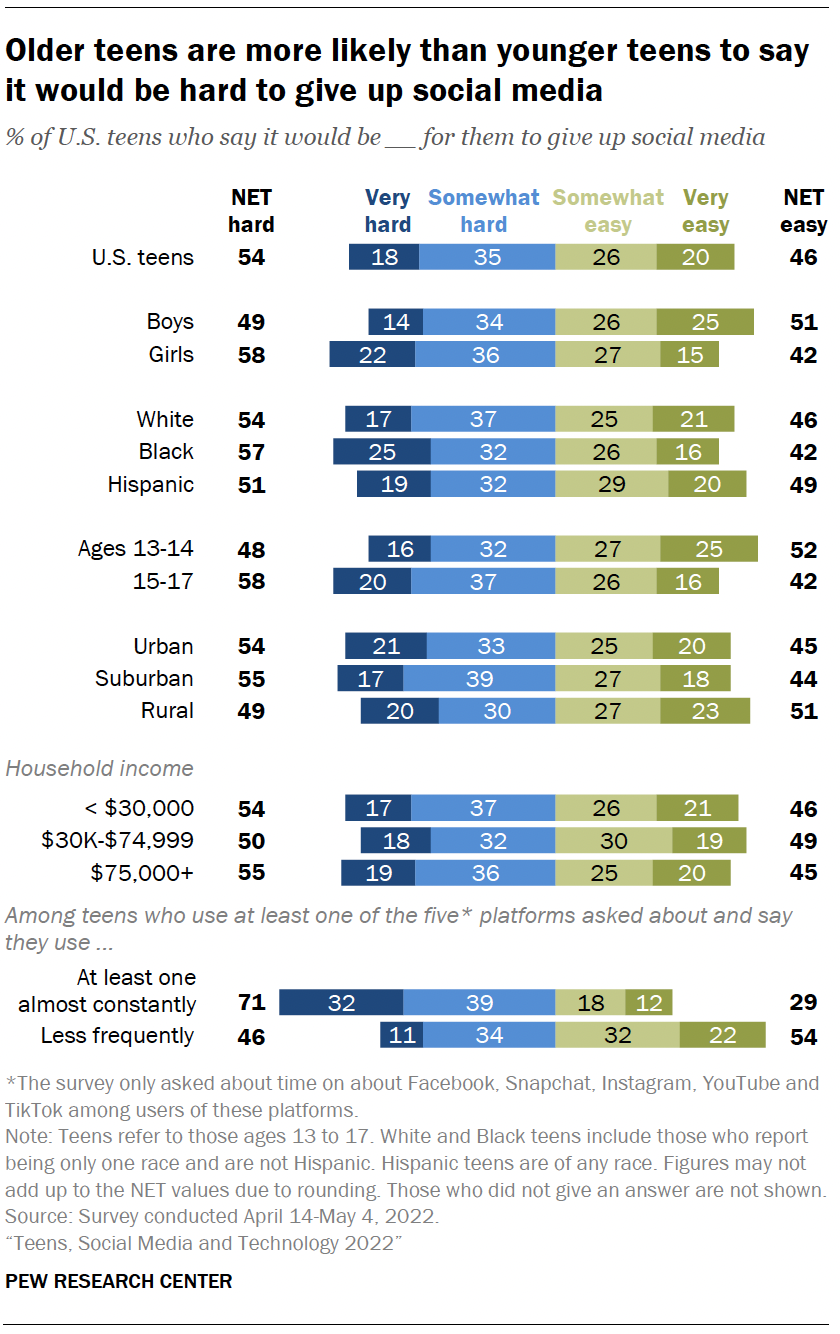
When reflecting on what it could be prefer to attempt to give up social media, teenagers are considerably divided whether or not this is able to be straightforward or tough. Some 54% of U.S. teenagers say it could be very (18%) or considerably laborious (35%) for them to surrender social media. Conversely, 46% of teenagers say it could be not less than considerably straightforward for them to surrender social media, with a fifth saying it could be very straightforward.
Teenage women are barely extra prone to say it could be laborious to surrender social media than teen boys (58% vs. 49%). An analogous hole is seen between older and youthful teenagers, with teenagers 15 to 17 years outdated being extra seemingly than 13- and 14-year-olds to say it could be not less than considerably laborious to surrender social media.
A majority of teenagers who use not less than one of many platforms requested about within the survey “virtually always” say it could be laborious to surrender social media, with 32% saying it could be very laborious. Smaller shares of teenagers who use not less than one among these on-line platforms however use them much less usually say the identical.
The teenagers who suppose they spend an excessive amount of time on social media additionally report they’d battle to step again fully from it. Teenagers who say they spend an excessive amount of time on social media are 36 proportion factors extra seemingly than teenagers who see their utilization as about proper to say giving up social media can be laborious (78% vs. 42%). Actually, about three-in-ten teenagers who say they use social media an excessive amount of (29%) say it could be very laborious for them to surrender social media. Conversely, a majority of teenagers who see their social media utilization as about proper (58%) say that it could be not less than considerably straightforward for them to present it up.






























































